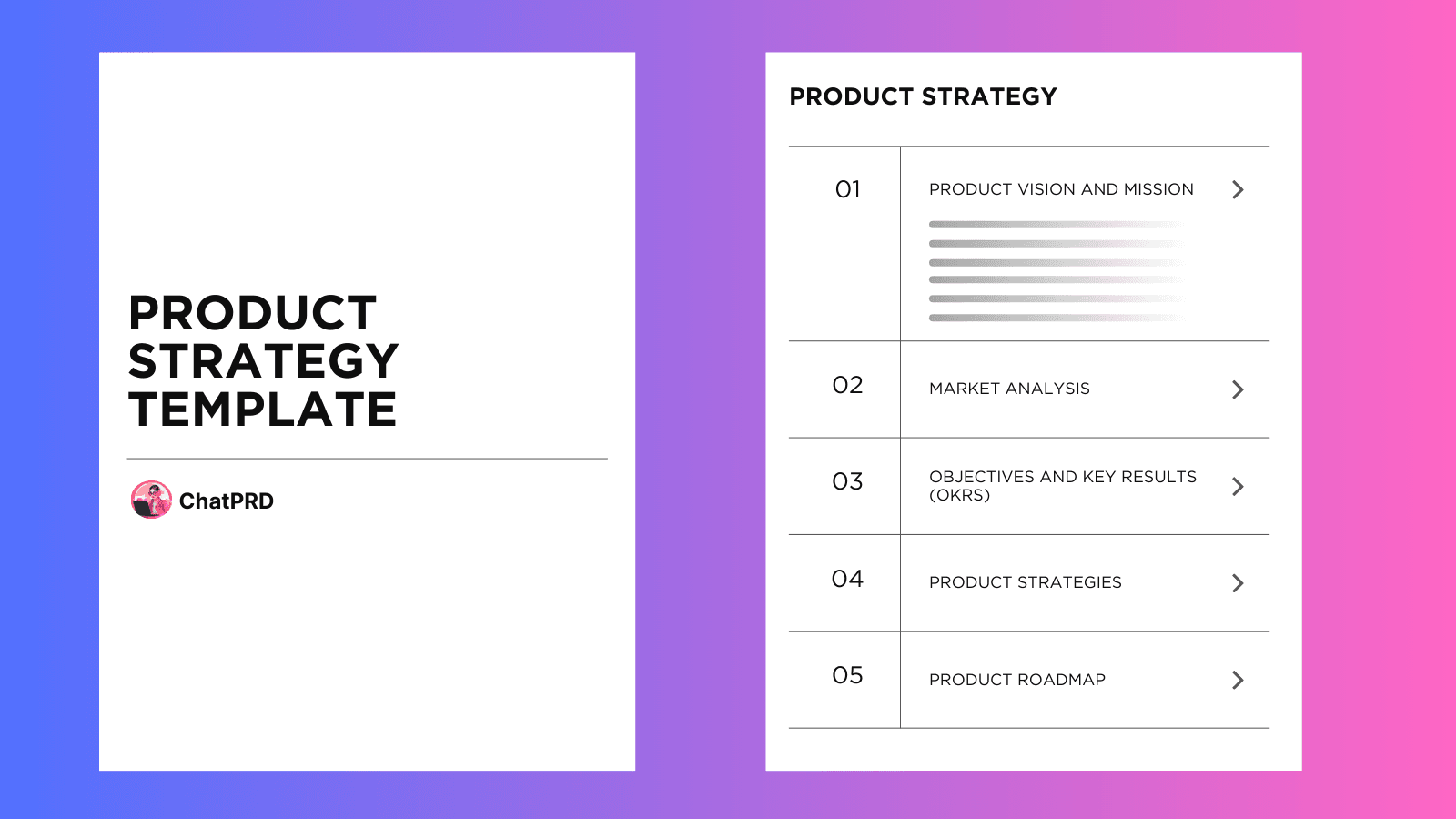Product Strategy Template
Our Product Strategy Template guides product managers in shaping and sharing a clear product vision and goals. It outlines actionable steps to align teams and drive results. This template fosters transparency, ensures consistency, and optimizes resource use. It helps teams focus on strategic priorities, leading to significant business outcomes and keeping everyone on the same page.
Use This Template with ChatPRDWhat is a Product Strategy?
A well-defined Product Strategy is the cornerstone of successful product management. It serves as the north star, guiding all product-related decisions and actions, ensuring alignment across teams, and driving impactful outcomes.
This Product Strategy template provides a structured and comprehensive framework for crafting your product strategy. Utilize it to define a clear vision, analyze market dynamics, set strategic objectives, formulate actionable plans, create a roadmap, and communicate your strategy effectively across all stakeholders.
By using this template, product leaders can ensure they cover all critical aspects of strategy development. It not only helps in aligning the team with the product vision but also provides clarity to stakeholders, ensuring everyone is on the same page. This enables the team to prioritize work efficiently and stay focused on delivering value.
Incorporating this template into your product management process will lead to better risk management and a clearer understanding of market opportunities and challenges. It streamlines decision-making and ensures that your product initiatives are strategically aligned with company goals, ultimately fostering long-term success.
When to use a Product Strategy:
When establishing a clear product vision and mission to provide unified direction for all team members.
When conducting a deep market analysis to uncover customer needs, industry trends, and competitive pressures.
When defining strategic objectives that align your product's roadmap with overarching business goals.
When crafting integrated product strategies that span development, marketing, and sales initiatives.
When developing a detailed product roadmap to synchronize team efforts and set realistic timeline expectations.
When presenting your product strategy to stakeholders to build consensus and secure necessary support.
When performing a thorough competitive analysis to distinguish your product's unique value proposition.
The Product Strategy Template
You can copy and paste this Product Strategy template to create your own, or use ChatPRD to generate it with AI.
Product Strategy
Author:Your Name Here
Product Vision and Mission
Define the overarching purpose and long-term impact of your product. Your Product Vision and Mission steer your strategy, providing focus and meaning.
Product Vision
Articulate the future state or ultimate aspiration of your product. It should be compelling and align with your company’s broader vision.
Product Mission
Convey what your product aims to achieve for its users and how it contributes to realizing your Product Vision.
Market Analysis
Gain a deep understanding of your market landscape. Identify industry trends, evaluate competitors, analyze your target audience, and pinpoint opportunities and threats.
Industry Trends
Identify and assess current and emerging trends that could influence your product and business.
Competitor Analysis
Evaluate your competitors’ strengths, weaknesses, opportunities, and threats (SWOT) comprehensively.
Target Audience Analysis
Profile your target audience: Understand their needs, behaviors, aspirations, and pain points.
Objectives and Key Results (OKRs)
Set precise, measurable, and attainable objectives for your product. Define key results to monitor progress and success in achieving these objectives.
Objectives
Define the high-level objectives for your product. Ensure they are specific, time-bound, and aligned with your Product Vision and broader company goals.
Key Results
Establish measurable outcomes that demonstrate achievement of your objectives. They should be quantifiable, realistic, and facilitate objective assessment.
Product Strategies
Craft strategic approaches in critical areas such as product development, marketing, sales, and customer success. These strategies should support your efforts in meeting the set Objectives.
Product Development Strategy
Detail your approach to improving and evolving your product. Discuss plans for feature development, UX/UI enhancements, and technical upgrades.
Marketing and Sales Strategy
Outline your approach to promoting your product and driving sales. Include positioning strategies, marketing campaigns, sales tactics, etc.
Customer Success Strategy
Describe your plan to ensure customer satisfaction and loyalty. Discuss support, education, retention, and upsell strategies.
Product Roadmap
Create a detailed, time-specific plan outlining your product’s trajectory. Include new features, enhancements, key milestones, and timelines.
Feature Development
Outline planned new features and improvements.
Milestones
Identify significant milestones in your product’s journey.
Timeline
Establish the timeframe for achieving these milestones and releasing features.
Template in Use
Example Product Strategy
Have ChatPRD generate a perfect
Product Strategy for you

ChatPRD is a no-code AI tool that can generate product requirements documents, user stories, and more.
Use this template with ChatPRD to create your own Product Strategy in minutes.
Explore More Templates
Product Launch Checklist Template
The Product Launch Checklist Template is an essential tool for product managers aiming to execute flawless launches. This comprehensive, step-by-step guide ensures no critical task goes overlooked, significantly increasing efficiency and mitigating risks. Organized into clear, sequential sections, this template covers all stages of a product launch, from initial concept to post-launch analysis, enabling a holistic and organized approach to bringing products to market successfully.
Issue Tracker Template
The Issue Tracker template empowers product managers to meticulously track, manage, and swiftly resolve product issues. It provides a structured approach to organizing identified issues, assigning priorities, and detailing resolution steps. This template not only records updates on fixes but also streamlines the entire process, facilitating efficient and timely resolution of product challenges.
Customer Feedback Form Template
This Customer Feedback Form template enables product managers to capture and analyze valuable customer feedback. By systematically collecting insights on user preferences, challenges, and suggestions, it informs strategic decisions. Using this template will help refine the product, elevate customer satisfaction, and drive continuous improvement in product quality.